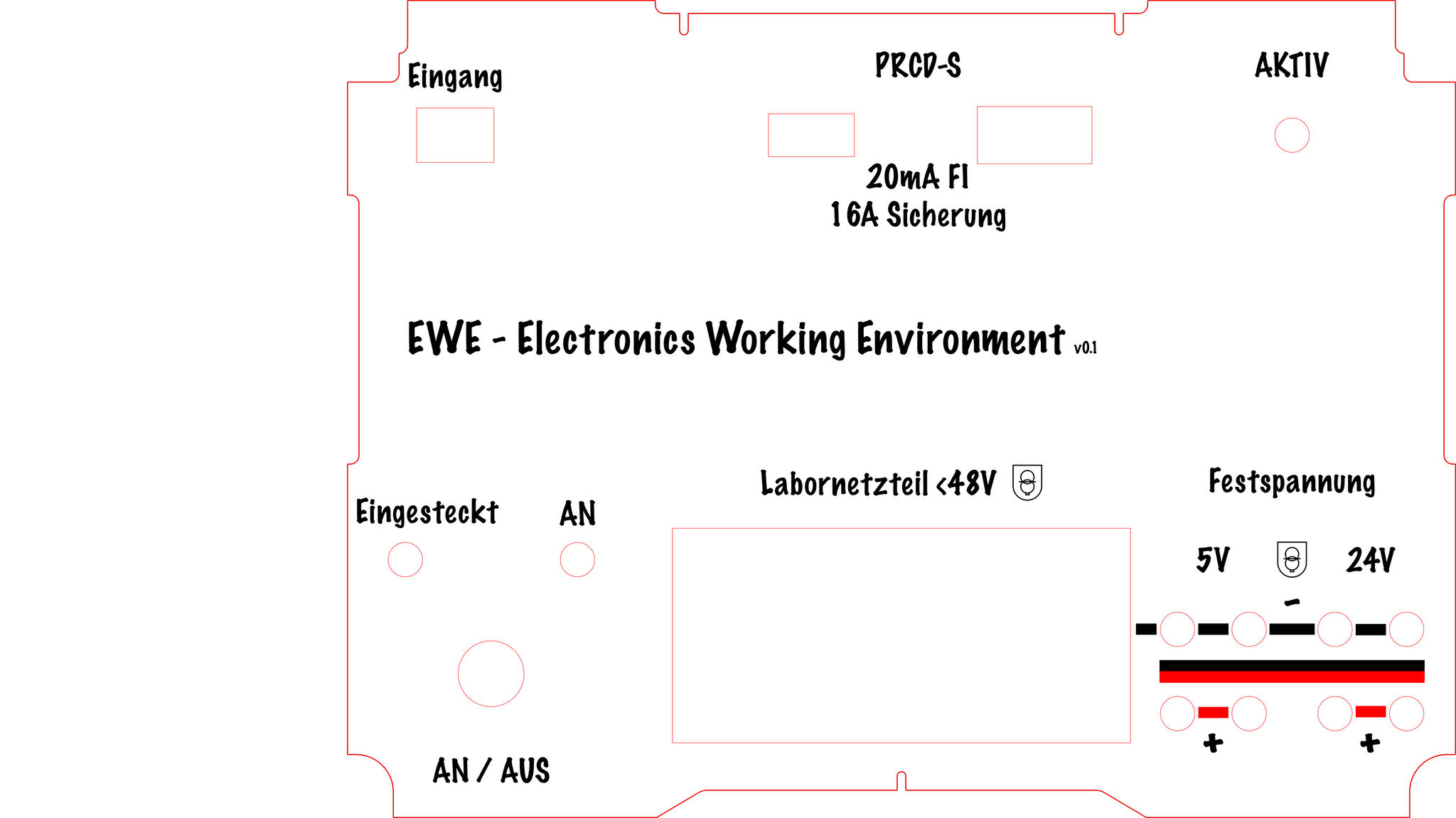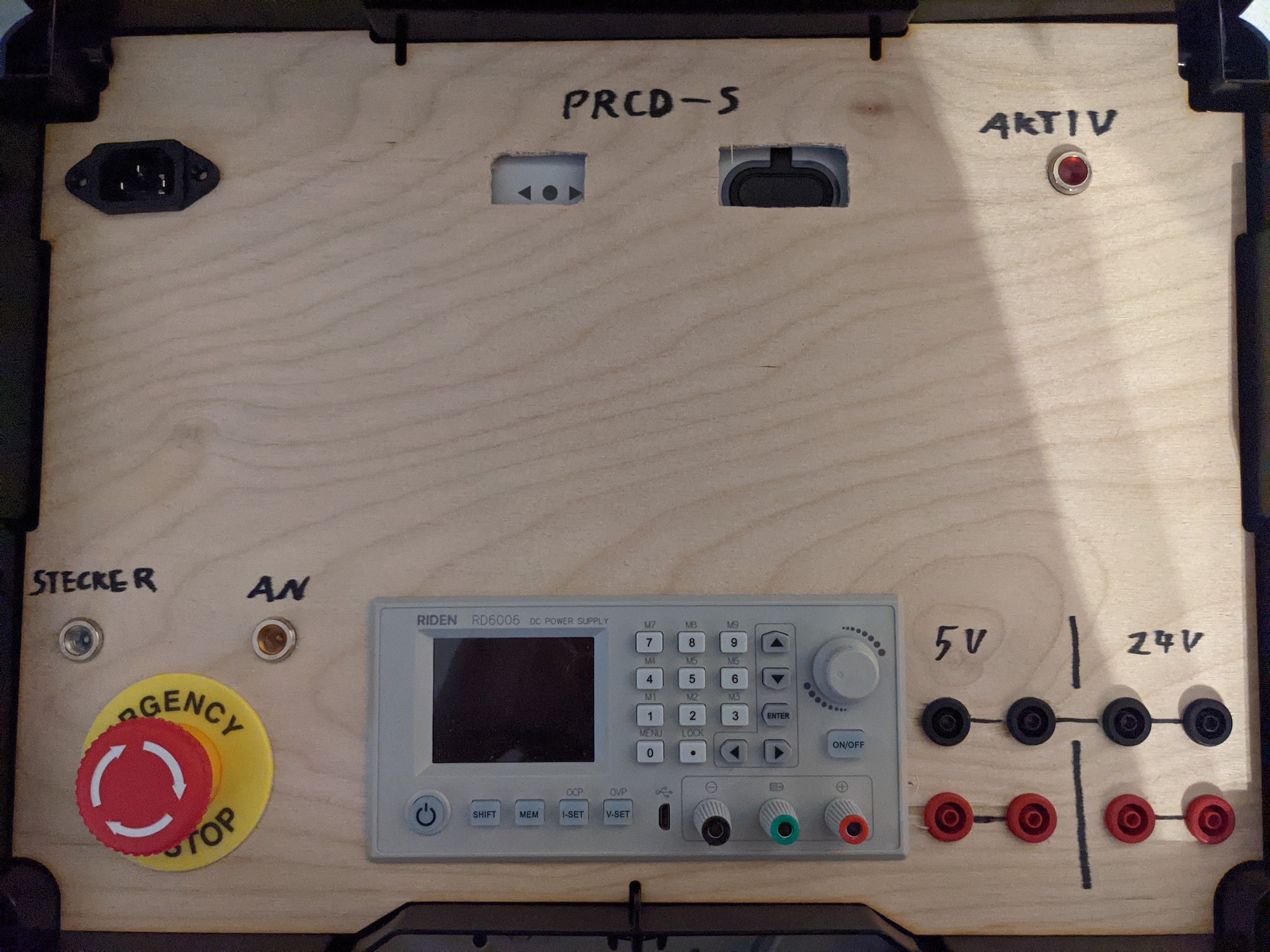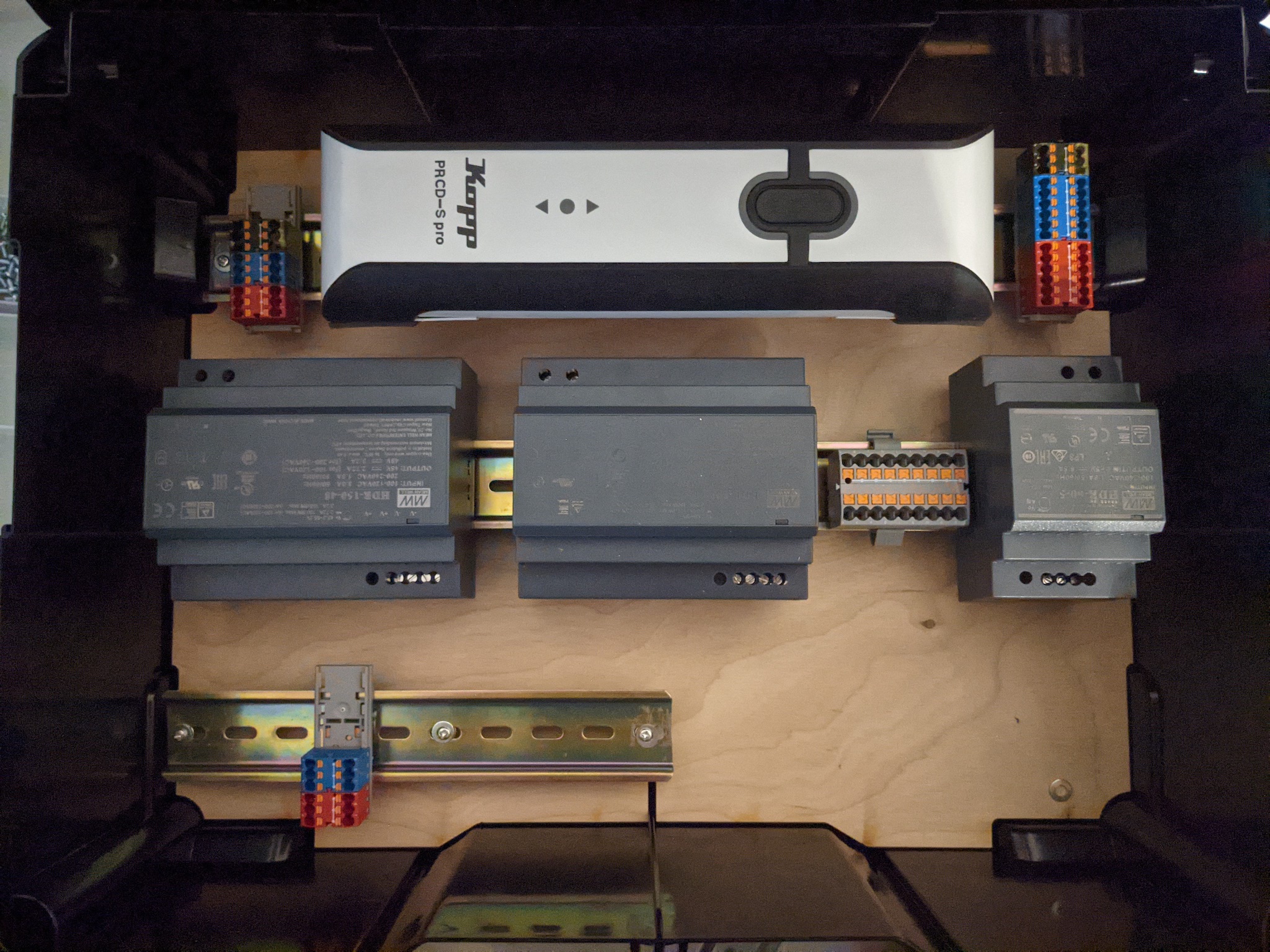A while back I started looking for a solution with which I could prove to be able to work safely from home while breaking devices. Sadly, I wasn’t able to find anything small and cheap enough to actually fit my desk. The best options I found where actual workbenches and tables in various sizes. Thus I decided to design my own Electronics Working Environment.
My Requirements
- Good enough to convince health and safety at work
- Contain all necessary components like fuses, emergency stop and RCD
- Be integrated so that a single test seal covers the whole setup
- Be a closed setup so I can actually show that I can’t just fiddle with it ;)
- Cheap enough for me to actually make, buy and develop
- Portable, to also be able to use it during odd jobs
- Small enough for a desk
- Be based on off-the-shelf components
- Usable
- Fixed voltage supplies for 5V and 24V and maybe 48V
- Adjustable power supply
- Maybe USB
- Maybe a safe 230V outlet
Standards & Safety
In preparation I read a few standards on the topic
- IEC 60499
- DIN VDE 0100
- DIN EN 60950-1/VDE 0805-1
- DIN EN 62368-1/VDE 0868-1
and created a list of hard requirements
- Emergency Stop
- It’s on all the lists and doesn’t hurt
- Lights to show the current state
- Create visibility
- RCD / Residual Current Device / German: FI
- Guess they’ve already saved my life a few times
- Best practice
- Be independent of the quality of the installation where one works
- Fuse
- Same as with the RCD
- Provide less than 60VDC
- Defined as the limit under which there is no risk for harm by electric shock
- Also ok for children’s toys
- Which is a good description for most Hackers :P
- Also ok for children’s toys
- I rarely work above 48VDC
- Defined as the limit under which there is no risk for harm by electric shock
- Provide PELV / SELV
- German: Sicherheitskleinspannung, Schutzkleinspannung
Protective Extra Low VoltageandSafety Extra Low Voltage- For SELV circuits a separation from earth/ground needs to be ensured, thus no ESD
- Use of safety power supplies
- Fulfilling PELV / SELV
- Certified
- Provide Ground for ESD?
- –> PELV
Components
Fuse & RCD
After a bit of research I, found something called PRCD-S / Portable Residual Current Device. A PRCD-S is an integrated device containing a fuse, an RCD and a circuit which ensures the availability of PE and the correct order/availability of N and L. In Germany craftsman are officially required by their professional association (BG/Berufsgenossenschaft) to use these devices when working at customer sites, to compensate for potentially bad electrical installations.
PRCD-S come integrated into extension cords, power strips, or as an individual device. For further details you could have a look at
prcd-s.info
.
For my setup the PRCD-S takes over the core safety functions I was looking. And due to being an off-the-shelf component I don’t have to worry about compliance and functionality.
Fixed Voltage Power Supplies
Wanting to rely on off-the-shelf components ensuring the necessary safety requirements for SELV/PELV I decided to search for applicable power supplies. After a bit of searching I found the Mean Well HDR-150 range of power supplies. Fullfilling Isolation Class II and being certified as providing SELV/PELV they simply do what I want. Wanting 5V, 24V and 48V I got all three.
Adjustable Power Supply
Working on an integrated setup, I started looking for panel mount power supplies and wasn’t able to find anything really nice. While not being exactly happy with it I chose to go for the Riden/Joy-IT RD6006. It’s a simple China power supply, taking up to 65V input and delivering about Vin - 10% output voltage at max 6A. Already having the 48V power supply, it’s able to deliver about 45VDC. As said, it’s not perfect and I’m still looking for something nicer, but it does the job.
Case
As I use Tanos Systainers for my tools, it seemed the perfect case for the setup. The size 2 offers enough height and the box itself fits everything. For my prototype Watterott Electronic lasered some wooden plates to fix the box and parts. For my final setup I’m going for Plexiglas/acrylic and a simple print.
Schematics
The following sketch gives a rough view of the internal setup

One important aspect is the connection between the ground contacts of all power supplies. This prevents running the power supplies in series and thus potentially increasing the supplied voltage above the allowed 60VDC
The Setup
Top Panel
The panel is straight forward and in the first version in German! ;-)
| Drawing | Picture |
|---|---|
 |
 |
Layout

Components #2
Sadly, the overall setup didn’t end up being quite as cheap as hoped for, but things simply cost money…
| Component | Amount | Price | Link |
|---|---|---|---|
| Tanos Systainer T-Loc size 2 | 1 | 35€ | Tanos Website |
| Mean Well HDR-60-5 | 1 | 25€ | Mean Well Website |
| Maen Well HDR-150-24 | 1 | 35€ | Mean Well Website |
| Mean Well HDR-250-48 | 1 | 40€ | Mean Well Website |
| Kopp PRCD-S pro | 1 | 155€ | Kopp Website |
| Riden/Joy-IT RD6006 | 1 | 80€ | Joy-IT Website |
| PHOENIX PTFIX 2,5mm2, Various | 20€ | Phoenix Contact Website | |
| Socket SEB 2600 Red | 4 | 2,50€ | SKS Kontakt Website |
| Socket SEB 2600 Black | 4 | 2,50€ | SKS Kontakt Website |
| LED 230V Red | 1 | 2€ | random |
| LED 230V Yellow | 1 | 2€ | random |
| LED 230V White | 1 | 2€ | random |
| Emergency Off Switch, 2 Pole | 1 | 20€ | random |
| Wooden / Plastic Panel Top & Bottom | 1 | 15€ | custom |
| Nuts & Bolts | 5€ | various | |
| Wires | 5€ | various | |
| DIN Rails | 5 | 2,50€ | random |
| All in All | :) | < 500€ | :) |